Inviting Those Outside In
Open those Orthodox Church doors wide!
Some time has passed since I last wrote here. I started teaching at Embry-Riddle Aeronautical University at the end of August. (Here is my faculty profile, in case you're interested: https://faculty.erau.edu/Elke.Speliopoulos.)
As a result, my time has been significantly limited. I am teaching three sections this semester, which is just one short of a full-time load. This has meant that I haven’t had time to produce much content for my Abun d’Bashmayo social media channel(s).
Recently, however, I got the chance to record the video below. If you have the time, feel free to watch it.
It was triggered by a comment that was left on one of my other Substack posts:
The challenge thrown out here by this commentator is a very valid one. There are only a few Syriac Orthodox sources I can refer him to online. Some of our priests and deacons have begun social media presences in Germany, the Netherlands, Canada, and the US. But they are few. I have a social media channel, but I am a) a convert, and b) a woman. While I hold several seminary degrees, they don’t carry the same weight as those of a clergy person.
What I discuss in the video are two things:
1) the language and cultural disconnect I feel, even after having been in my Syriac Orthodox church in Phoenix for the past 2 1/2 plus years, and
2) the lack of a well-thought-out welcome I perceive for visitors in my church.
Here are some observations from a convert to Syriac Orthodoxy:
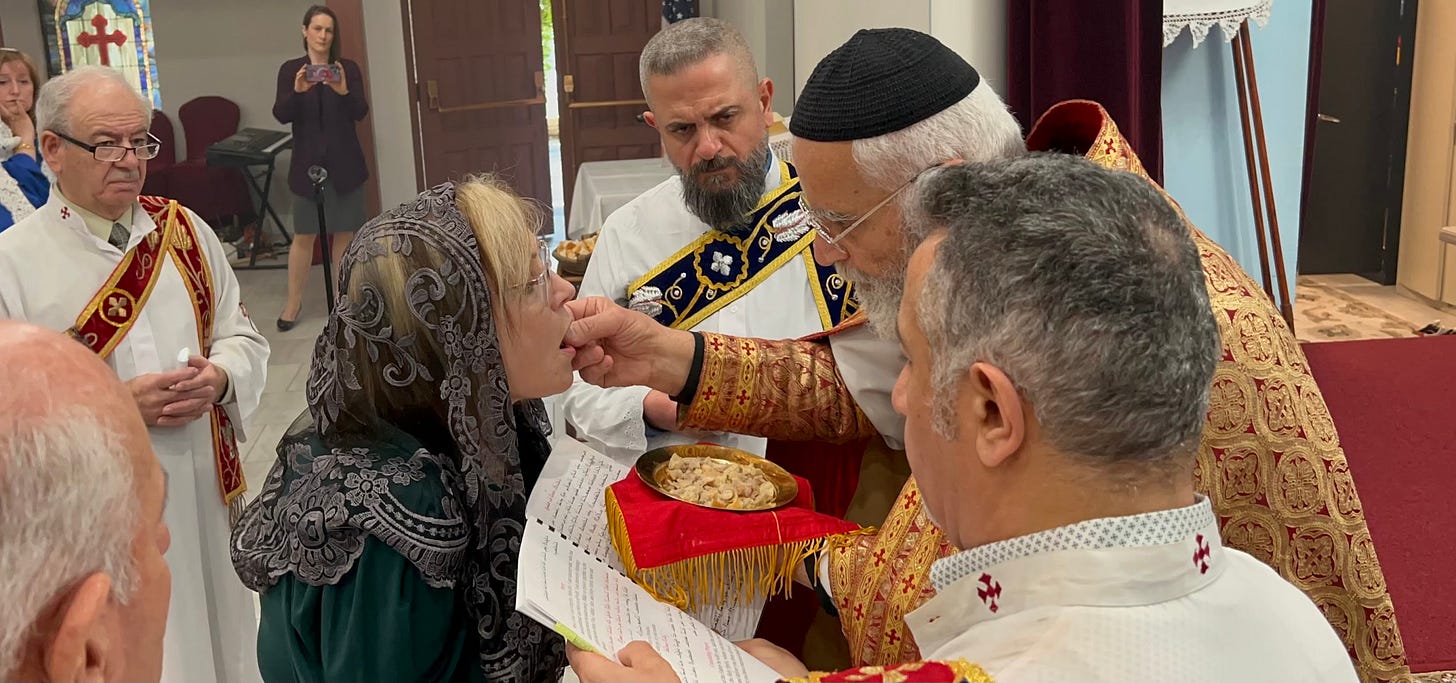
As a non-Arabic speaker, it is sometimes very difficult to follow the Holy Qurobo. I have accepted that the liturgy is part Syriac (which I am learning) and part Arabic, and I am navigating through it. I can figure out the Scripture readings since they are on our calendar. For the most part, I can follow the liturgy thanks to a liturgy book that translates the major parts of it into English.
Although I have to say, one part of the liturgy was never clear to me, and I couldn’t find it in my liturgy book at all. After all this time being at St. Mary’s Syriac Orthodox Church, I was finally able to obtain the Syriac text (with English translation) of The Service of the Mother of God and the Saints. TAUDI SAGI to Abouna Zmargdos, who ensured I received it.
But as soon as the sermon starts, I am out of luck: it’s in Arabic. No translation is offered. I have resorted to recording the homilies, then uploading them to YouTube in the evening when I return home. YouTube offers an auto translation, which allows me to at least get the gist of what was said by my priest.
The same goes for the announcements. Nothing is offered in English, and I am often forced to ask others after the liturgy if I am missing anything important. It used to be that even the Facebook announcements were only in Arabic, which isn’t a big deal unless they are in an image. Facebook will otherwise offer a translation (albeit a poor one) for text passages.
As a non-Arabic speaker, it is also very difficult for me to form friendships at my church. Most of the women my age don’t speak much English. A few of our lovely ladies try to sit with me so I can at least talk a little bit with them.
It’s a little bit better with the men, but they always sit on the far side of the room during the fellowship time, so I don’t get to interact much there. Again, I will say that some very sweet people try to always speak with me. I feel bad that I don’t speak Arabic, but I simply don’t see that I will learn it at this point in life. I am learning Syriac, so there’s that.
Most of the younger people speak English, but they usually sit in a different area with people their own age. I don’t feel comfortable “crashing” there. Plus, they speak in Arabic, too, most of the time.
The same happens when I want to tune in to online events. 9 times out of 10, they are in Arabic without any translation offered. Not helpful for converts or those seeking.
All this to say, it is awfully hard for a convert. The picture in Germany wasn’t too much better, except there it was Turoyo, rather than Arabic. At least during the coffee hour, it was significantly easier to find people to speak German with. This group has been in Germany much longer than my Iraqi immigrant fellow-parishioners here in the US.
At the request of my priest and with the blessing of our archbishop, I teach a weekly youth and young adult Bible study. Here is this past Friday’s session.
We look at the gospel passage of the following Sunday in light of our Syriac and other pre-Chalceonian writers. There is a realization that we need to teach our young people in English.
I shared this online meeting with several priests in the western US whom I know, inviting them to invite their young people, but only two showed an interest and actually referred young people to our study. So there are glimpses of a realization that things need to change but not enough action to use the channels available.
Having said all this, I know that my husband’s Greek Orthodox church growing up was the exact same. Everything was in Greek, and my husband as a second-generation American doesn’t speak Greek anymore. This led to him leaving the church behind as a young adult. I have written elsewhere about it. A few months ago, he shared a Facebook post with me that showed that his childhood parish was merging with another parish, and the church he used to go to would close.
This is the fear I have for our Syriac Orthodox churches if we don’t very quickly devise an action plan to not only maintain what is there today (or rather who), but how we can become a more missional church.
In the video, I contrast this with my husband’s Greek Orthodox church, who dropped the “Greek” part from their name a while ago. They are only “St. George Orthodox Church of Prescott,” and anyone is welcome there. The Divine Liturgy is in English, the hymnody is in English, the fellowship is in English.
When people decide to visit the church, they are immediately greeted outside of the church building by greeters who engage them, get some basic contact data from them, and give them a liturgy book that helps them follow the Divine Liturgy. It has both the text of the Divine Liturgy of St. John Chryostom, but they also have pages that explain alongside the liturgical text what people are experiencing who may see an Orthodox liturgy for the first time.
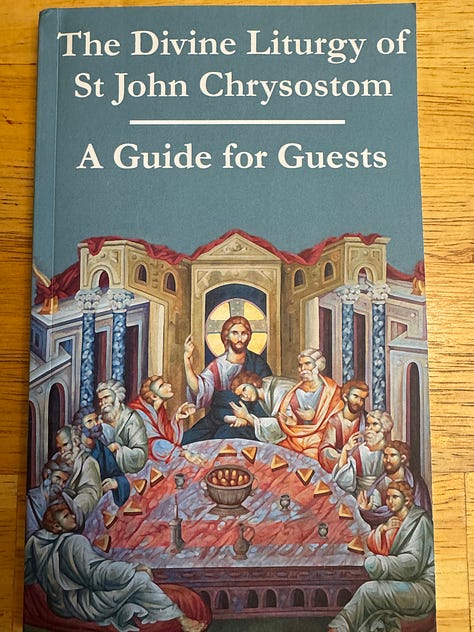




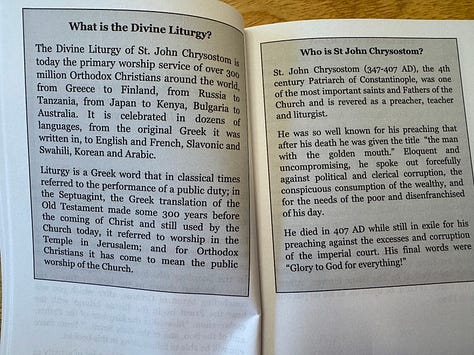
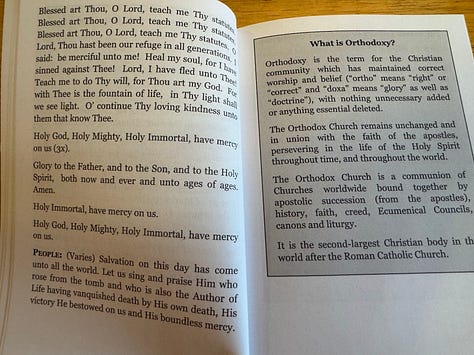

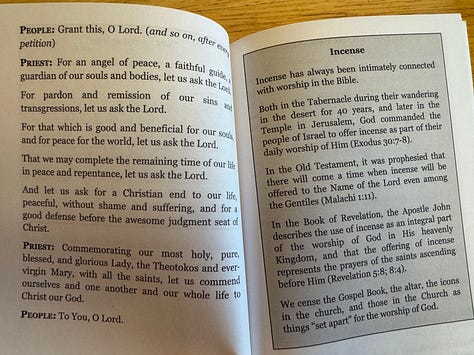
The visitors are shown inside, a seat is pointed out to them, and it is explained to them that the Orthros (morning prayers) are currently being prayed, and that the actual liturgy will begin when the priest says, “Blessed is the Kingdom of the Father and of the Son and of the Holy Spirit, now and forever and to the ages of ages.” They learn that, while they may not take communion unless they are Orthodox, they are welcome to come up for a blessing from the priest during communion and for Antidoron (blessed bread) after the liturgy.
After the Divine Liturgy, a person will invite the visitor to the Agape Lunch hour and will guide them to the fellowship hall. They will connect the visitor to a regular to have them further engage the visitor. The visitor is invited to get food, to take a book for free, and to get a tour of the church, if they desire. A follow-up is initiated in the week after they visitor visited.
St. George Orthodox is currently experiencing rapid growth because of the Holy Spirit’s guiding toward such a proactive visitor approach.
These are concrete steps that could be adopted by our Syriac Orthodox Church, but it will take time, money, and people to do it! Additionally, as a church, we need to have the discussion if the time is ripe for an English mission church approach that would hopefully reach across the aisle to the Jacobite Syriac Orthodox Church, our Indian brethren, who fight the same language battle, even though it is Malayalam for them.
If we do not very quickly begin a concerted effort to put in place recommendations and tools for our Syriac Orthodox parishes, they may go the way of my husband’s childhood parish where nothing changed, ethnic and language preferences prevailed, and it eventually found a natural end, or should we call it unnatural?
My prayer is for the Holy Spirit to proverbially “kick some butt” in our leadership to make this a priority. In other words, to produce action that helps turn this beautiful ark of our Syriac Orthodox Church in the direction that allows those afloat in a theological ocean to climb aboard our rescue boats.


